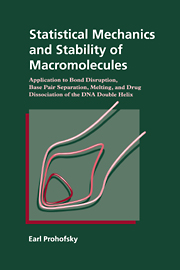 Statistical Mechanics and Stability of Macromolecules
Statistical Mechanics and Stability of Macromolecules Book contents
- Frontmatter
- Contents
- Preface
- 1 Introduction
- 2 Macromolecular stability
- 3 Lattice dynamics
- 4 Effective phonon theory
- 5 Premelting disrupted chemical bonds
- 6 Cooperative melting
- 7 Strained chemical bonds: salt and pressure effects
- 8 Bond disruption and conformation change: B to Z conformation change in DNA
- 9 Hydration effects: structural water
- 10 Helix with daunomycin intercalated: increased helix stability and daunomycin-DNA binding constant
- 11 Nonrepeating DNA
- 12 Cutting and splicing: junctions, inserts, and the replicating fork
- 13 Interaction between a helix and a single attached molecule
- 14 Energy considerations in bond opening
- Appendix 1 Helical lattice dynamics
- Appendix 2 Density matrix and effective phonon theory
- Appendix 3 Green functions
- References
- Index
14 - Energy considerations in bond opening
Published online by Cambridge University Press: 16 September 2009
- Frontmatter
- Contents
- Preface
- 1 Introduction
- 2 Macromolecular stability
- 3 Lattice dynamics
- 4 Effective phonon theory
- 5 Premelting disrupted chemical bonds
- 6 Cooperative melting
- 7 Strained chemical bonds: salt and pressure effects
- 8 Bond disruption and conformation change: B to Z conformation change in DNA
- 9 Hydration effects: structural water
- 10 Helix with daunomycin intercalated: increased helix stability and daunomycin-DNA binding constant
- 11 Nonrepeating DNA
- 12 Cutting and splicing: junctions, inserts, and the replicating fork
- 13 Interaction between a helix and a single attached molecule
- 14 Energy considerations in bond opening
- Appendix 1 Helical lattice dynamics
- Appendix 2 Density matrix and effective phonon theory
- Appendix 3 Green functions
- References
- Index
Summary
Source of energy
There is a direction to both replication and transcription that is not random. Both processes involve a complex of enzymes that move along the helix generating a copy of the information contained in the helix base sequence. One would expect, based on our understanding of the second law of thermodynamics, that these operations would require some kind of thermodynamic engine that would irreversibly burn energy and create entropy to allow the directed work to occur. The most common analysis of second law engines is in terms of Carnot engines that take in energy, do work, and exhaust energy which is the source of the increase in entropy. One question that could be asked is, to what extent can these local biological processes carried out by specific molecular complexes be described in terms of Carnot engines? Whether or not the process is Carnot-like, the investigation of processes driven by a flow of energy is an important problem and very little studied to date.
The complexes that do the work are made up only of macromolecules and a molecular engine has to be described differently than a macroscopic engine. Macro engines are classical systems that allow continuous heat flows into and out of the engine. Molecular systems are quantum systems in which the nearest equivalent to heat inflow is the absorption of particular excitations. The heat storage in a molecule is in terms of excitation levels of quantized modes of the system.
- Type
- Chapter
- Information
- Statistical Mechanics and Stability of MacromoleculesApplication to Bond Disruption, Base Pair Separation, Melting, and Drug Dissociation of the DNA Double Helix, pp. 181 - 192Publisher: Cambridge University PressPrint publication year: 1995
